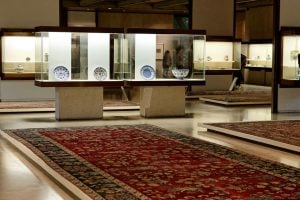The collection is devoted to European art, with sections having written books illuminated, the ivories, paintings, sculptures, medals, of tapestries and fabrics, and furniture pieces, to jewelery and of glassware. These objects represent the artistic manifestations that have emerged in different regions of the 11th to the middle of 20th century.
The European decorative arts section is introduced by sixteenth-century tapestries from Flanders and Italy.Outstanding 18th century French works include Gobelins, Beauvais and Aubusson tapestries, very fine sets of furniture dating from the time of the Regency, Louis XV and Louis XVI, made by Cressent, Oeben, Riesener, Jacob, Carlin and Sené. Also on display are pieces in silver or gold by the best French craftsmen such as F.-T. Germain, Duran, Lehendrick, Roettiers and Auguste.
Calouste Gulbenkian Museum
The Calouste Gulbenkian Foundation was created in 1956 by the last will and testament of Calouste Sarkis Gulbenkian, a philanthropist of Armenian origin who lived in Lisbon between 1942 and the year of his death, 1955.
Established in perpetuity, the Foundation’s main purpose is to improve the quality of life through art, charity, science and education. The Foundation directs its activities from its headquarters in Lisbon and its delegations in Paris and London, with support provided by Portugal in Portuguese-speaking African Countries (PALOP) and East Timor, as well as in countries with Armenian Communities.
The Foundation has a museum, which houses the Founder’s private collection, alongside a collection of modern and contemporary art; an orchestra and a choir; an art library and archive; a scientific research institute; and a garden, in a central area of the city of Lisbon, where educational activities also take place.
In conjunction with cultural activities, the Foundation fulfils its mission through innovative programmes that develop pilot projects and support, by providing scholarships and grants for other institutions and social organisations.
Founder’s Collection
The building that houses the Founder’s Collection was designed by the architects Ruy Jervis d’Athouguia, Pedro Cid and Alberto Pessoa (1969) to accommodate around six thousand pieces amassed by Calouste Sarkis Gulbenkian. It is located in the north of the Gulbenkian garden.
The galleries of this building are home to displays of around a thousand pieces divided into groups corresponding to Egyptian art, Greco-Roman art, Mesopotamia, the Islamic Orient, Armenia, the Far East and, where Western art is concerned, sculpture, the art of the book, painting, eighteenth-century French decorative arts, and works by René Lalique. The collection of works by René Lalique, which Calouste Gulbenkian purchased directly from the artist, is considered to be unique in the world for its quality and quantity.









